Nalanda Mahavihara: An Ancient Center of Higher Education
VerifiedAdded on 2023/06/12
|10
|2977
|333
AI Summary
Nalanda Mahavihara is an archeological site of an ancient Buddhist monastery, which was built around the fifth century C.E. It was built originally by Emperor Kumaragupta I from the Gupta Dynasty, and during the later Gupta period, further expansions took place in the Monastery. The monastery served as the center of knowledge, and education, and in sense was one of the earliest universities. This article explores the history and significance of Nalanda Mahavihara, its architecture, administration, and influence on Buddhism and education.
Contribute Materials
Your contribution can guide someone’s learning journey. Share your
documents today.
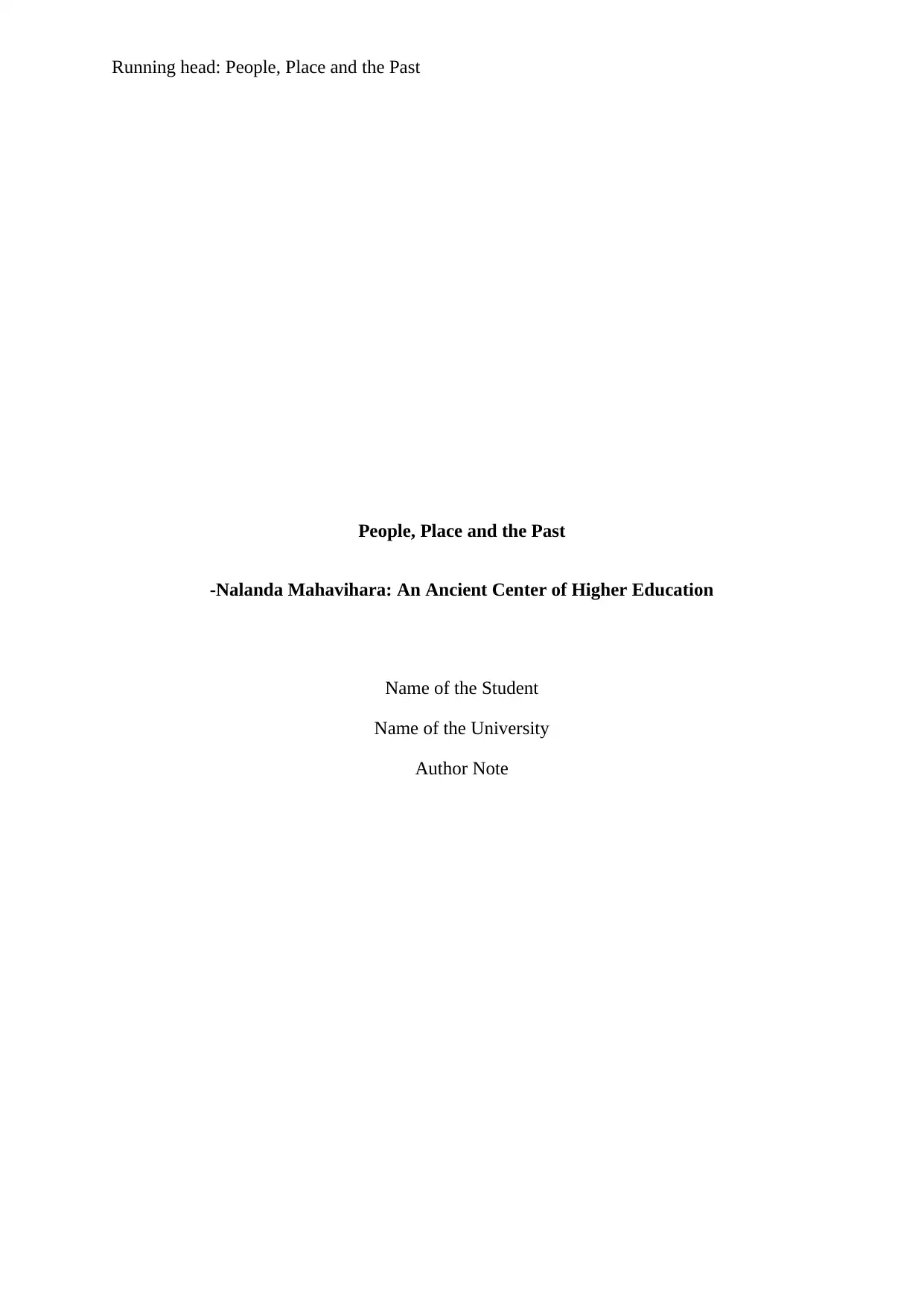
Running head: People, Place and the Past
People, Place and the Past
-Nalanda Mahavihara: An Ancient Center of Higher Education
Name of the Student
Name of the University
Author Note
People, Place and the Past
-Nalanda Mahavihara: An Ancient Center of Higher Education
Name of the Student
Name of the University
Author Note
Secure Best Marks with AI Grader
Need help grading? Try our AI Grader for instant feedback on your assignments.
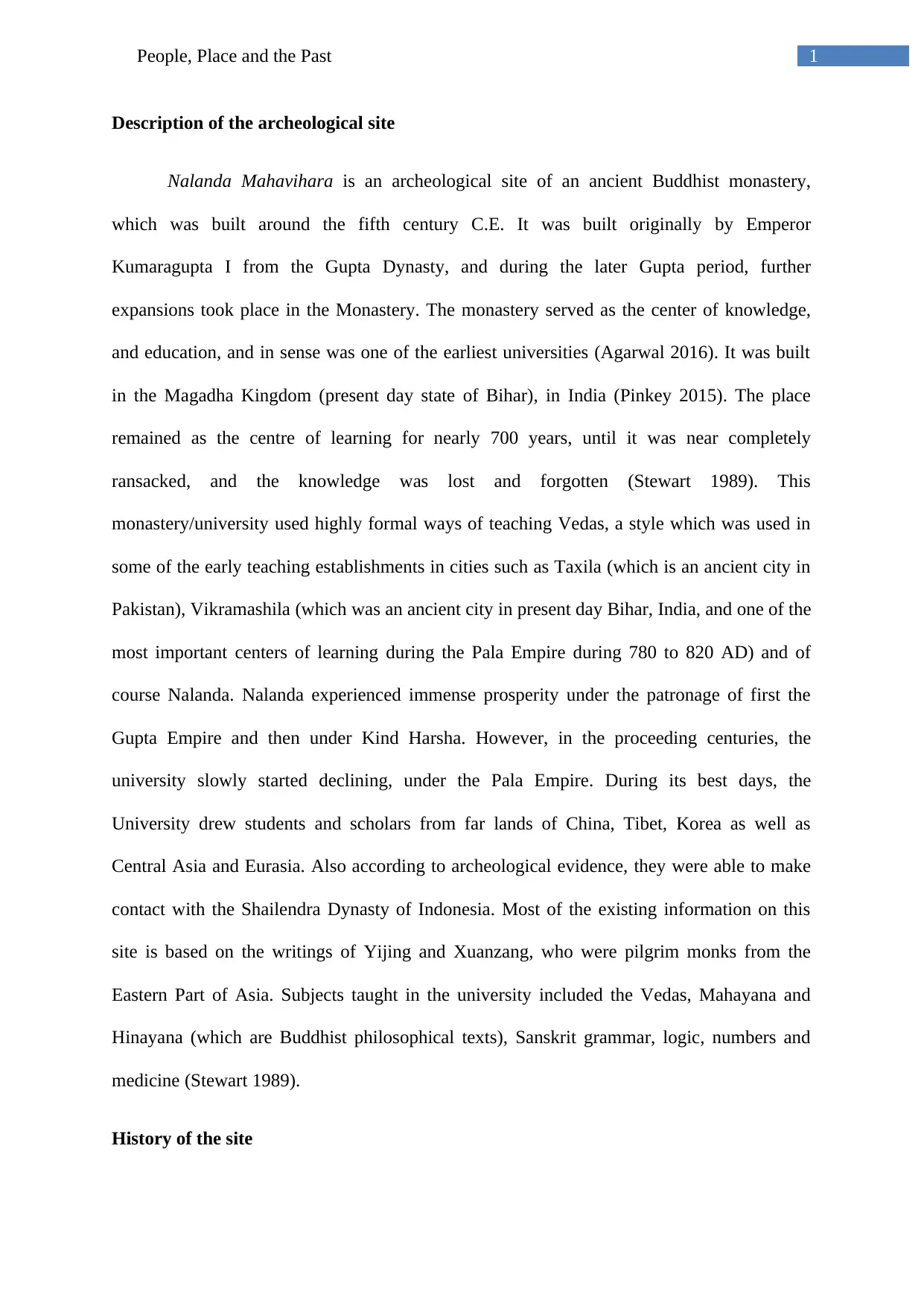
1People, Place and the Past
Description of the archeological site
Nalanda Mahavihara is an archeological site of an ancient Buddhist monastery,
which was built around the fifth century C.E. It was built originally by Emperor
Kumaragupta I from the Gupta Dynasty, and during the later Gupta period, further
expansions took place in the Monastery. The monastery served as the center of knowledge,
and education, and in sense was one of the earliest universities (Agarwal 2016). It was built
in the Magadha Kingdom (present day state of Bihar), in India (Pinkey 2015). The place
remained as the centre of learning for nearly 700 years, until it was near completely
ransacked, and the knowledge was lost and forgotten (Stewart 1989). This
monastery/university used highly formal ways of teaching Vedas, a style which was used in
some of the early teaching establishments in cities such as Taxila (which is an ancient city in
Pakistan), Vikramashila (which was an ancient city in present day Bihar, India, and one of the
most important centers of learning during the Pala Empire during 780 to 820 AD) and of
course Nalanda. Nalanda experienced immense prosperity under the patronage of first the
Gupta Empire and then under Kind Harsha. However, in the proceeding centuries, the
university slowly started declining, under the Pala Empire. During its best days, the
University drew students and scholars from far lands of China, Tibet, Korea as well as
Central Asia and Eurasia. Also according to archeological evidence, they were able to make
contact with the Shailendra Dynasty of Indonesia. Most of the existing information on this
site is based on the writings of Yijing and Xuanzang, who were pilgrim monks from the
Eastern Part of Asia. Subjects taught in the university included the Vedas, Mahayana and
Hinayana (which are Buddhist philosophical texts), Sanskrit grammar, logic, numbers and
medicine (Stewart 1989).
History of the site
Description of the archeological site
Nalanda Mahavihara is an archeological site of an ancient Buddhist monastery,
which was built around the fifth century C.E. It was built originally by Emperor
Kumaragupta I from the Gupta Dynasty, and during the later Gupta period, further
expansions took place in the Monastery. The monastery served as the center of knowledge,
and education, and in sense was one of the earliest universities (Agarwal 2016). It was built
in the Magadha Kingdom (present day state of Bihar), in India (Pinkey 2015). The place
remained as the centre of learning for nearly 700 years, until it was near completely
ransacked, and the knowledge was lost and forgotten (Stewart 1989). This
monastery/university used highly formal ways of teaching Vedas, a style which was used in
some of the early teaching establishments in cities such as Taxila (which is an ancient city in
Pakistan), Vikramashila (which was an ancient city in present day Bihar, India, and one of the
most important centers of learning during the Pala Empire during 780 to 820 AD) and of
course Nalanda. Nalanda experienced immense prosperity under the patronage of first the
Gupta Empire and then under Kind Harsha. However, in the proceeding centuries, the
university slowly started declining, under the Pala Empire. During its best days, the
University drew students and scholars from far lands of China, Tibet, Korea as well as
Central Asia and Eurasia. Also according to archeological evidence, they were able to make
contact with the Shailendra Dynasty of Indonesia. Most of the existing information on this
site is based on the writings of Yijing and Xuanzang, who were pilgrim monks from the
Eastern Part of Asia. Subjects taught in the university included the Vedas, Mahayana and
Hinayana (which are Buddhist philosophical texts), Sanskrit grammar, logic, numbers and
medicine (Stewart 1989).
History of the site
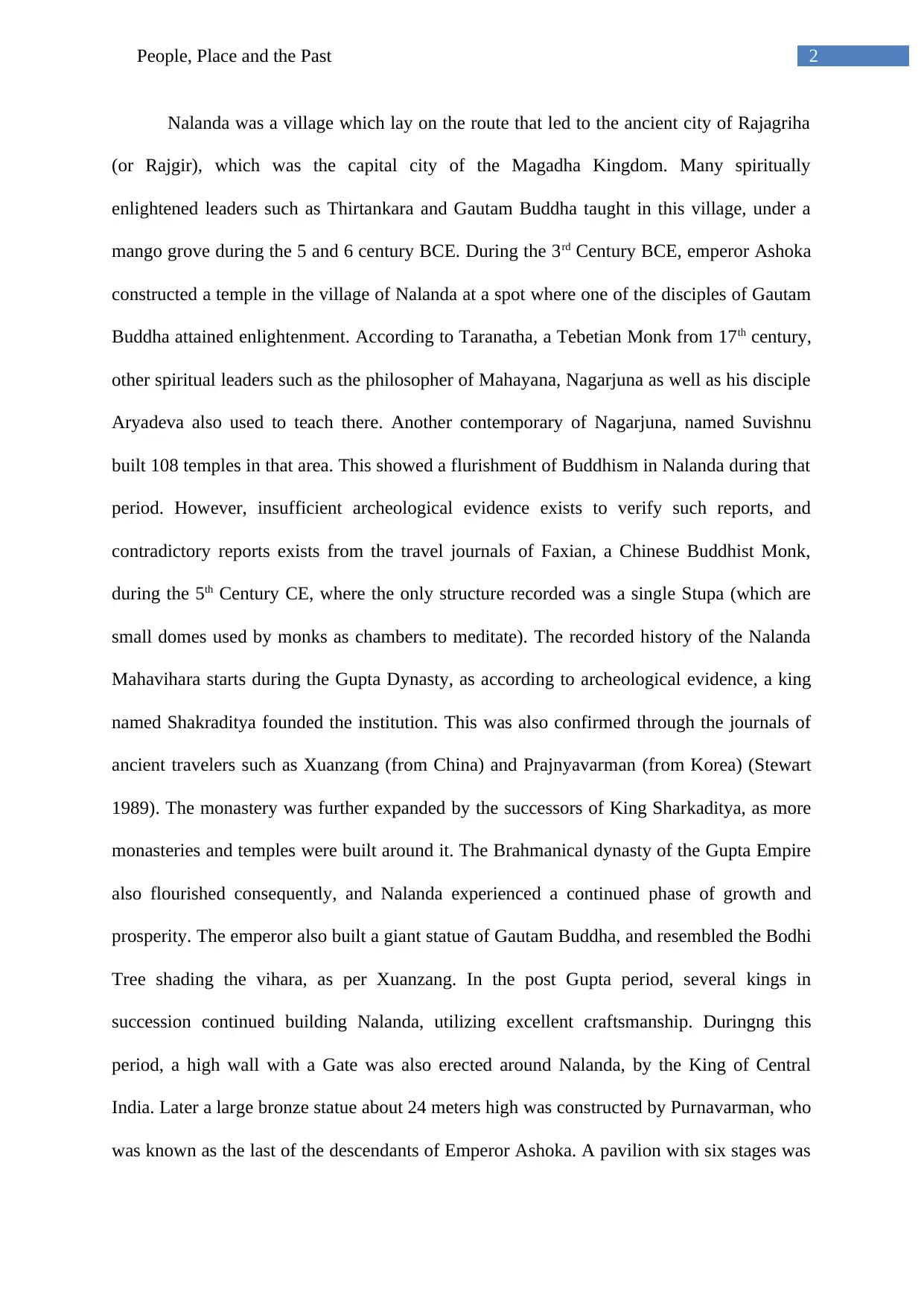
2People, Place and the Past
Nalanda was a village which lay on the route that led to the ancient city of Rajagriha
(or Rajgir), which was the capital city of the Magadha Kingdom. Many spiritually
enlightened leaders such as Thirtankara and Gautam Buddha taught in this village, under a
mango grove during the 5 and 6 century BCE. During the 3rd Century BCE, emperor Ashoka
constructed a temple in the village of Nalanda at a spot where one of the disciples of Gautam
Buddha attained enlightenment. According to Taranatha, a Tebetian Monk from 17th century,
other spiritual leaders such as the philosopher of Mahayana, Nagarjuna as well as his disciple
Aryadeva also used to teach there. Another contemporary of Nagarjuna, named Suvishnu
built 108 temples in that area. This showed a flurishment of Buddhism in Nalanda during that
period. However, insufficient archeological evidence exists to verify such reports, and
contradictory reports exists from the travel journals of Faxian, a Chinese Buddhist Monk,
during the 5th Century CE, where the only structure recorded was a single Stupa (which are
small domes used by monks as chambers to meditate). The recorded history of the Nalanda
Mahavihara starts during the Gupta Dynasty, as according to archeological evidence, a king
named Shakraditya founded the institution. This was also confirmed through the journals of
ancient travelers such as Xuanzang (from China) and Prajnyavarman (from Korea) (Stewart
1989). The monastery was further expanded by the successors of King Sharkaditya, as more
monasteries and temples were built around it. The Brahmanical dynasty of the Gupta Empire
also flourished consequently, and Nalanda experienced a continued phase of growth and
prosperity. The emperor also built a giant statue of Gautam Buddha, and resembled the Bodhi
Tree shading the vihara, as per Xuanzang. In the post Gupta period, several kings in
succession continued building Nalanda, utilizing excellent craftsmanship. Duringng this
period, a high wall with a Gate was also erected around Nalanda, by the King of Central
India. Later a large bronze statue about 24 meters high was constructed by Purnavarman, who
was known as the last of the descendants of Emperor Ashoka. A pavilion with six stages was
Nalanda was a village which lay on the route that led to the ancient city of Rajagriha
(or Rajgir), which was the capital city of the Magadha Kingdom. Many spiritually
enlightened leaders such as Thirtankara and Gautam Buddha taught in this village, under a
mango grove during the 5 and 6 century BCE. During the 3rd Century BCE, emperor Ashoka
constructed a temple in the village of Nalanda at a spot where one of the disciples of Gautam
Buddha attained enlightenment. According to Taranatha, a Tebetian Monk from 17th century,
other spiritual leaders such as the philosopher of Mahayana, Nagarjuna as well as his disciple
Aryadeva also used to teach there. Another contemporary of Nagarjuna, named Suvishnu
built 108 temples in that area. This showed a flurishment of Buddhism in Nalanda during that
period. However, insufficient archeological evidence exists to verify such reports, and
contradictory reports exists from the travel journals of Faxian, a Chinese Buddhist Monk,
during the 5th Century CE, where the only structure recorded was a single Stupa (which are
small domes used by monks as chambers to meditate). The recorded history of the Nalanda
Mahavihara starts during the Gupta Dynasty, as according to archeological evidence, a king
named Shakraditya founded the institution. This was also confirmed through the journals of
ancient travelers such as Xuanzang (from China) and Prajnyavarman (from Korea) (Stewart
1989). The monastery was further expanded by the successors of King Sharkaditya, as more
monasteries and temples were built around it. The Brahmanical dynasty of the Gupta Empire
also flourished consequently, and Nalanda experienced a continued phase of growth and
prosperity. The emperor also built a giant statue of Gautam Buddha, and resembled the Bodhi
Tree shading the vihara, as per Xuanzang. In the post Gupta period, several kings in
succession continued building Nalanda, utilizing excellent craftsmanship. Duringng this
period, a high wall with a Gate was also erected around Nalanda, by the King of Central
India. Later a large bronze statue about 24 meters high was constructed by Purnavarman, who
was known as the last of the descendants of Emperor Ashoka. A pavilion with six stages was

3People, Place and the Past
also build by the same ruler in Nalanda. After the Gupta Dynasty declined, King Harsha, of
Kanauj Empire in the 7th Century became the patron of the Mahavihara. He converted himself
to a Buddhist, and served the monks of the Mahavihara. King Harsha was a great supporter of
the Mahavihara, he constricted a monastery made from Brass inside the Mahavihara, and
provided them economic sustenance from the revenues of 10 villages, and under his
direction, and 200 households provided the monks of the Mahavihara with their food and
ration (Raj 2016). During the congregation of the Empire, almost a thousand monks were
present. Such records have been chiefly based on the journals of Xuanzang and Yijing in the
forms of ancient records of the Buddhist religion as it was practiced in the Indian
subcontinent and Malayan archipelago (Up̄asaka 1977).
Xuanzang travelled from China to India during 630 to 643 AD, and visited Nalanda
twice during that time, and spent about 2 years in the monastery. In Nalanda, he received a
warm welcome, and was also given the name Mokshadeva, and also studied under
Shilabhadra (who was the head of the institute). According to Xuanzhang, Shilabhadra was
an incomparable teacher, who taught him Yogachara, which he was able to transmit partially
to China.He also learnt other subjects taught in the Mahavihara, such as logic and grammar
and later also taught there. He later returned to China with 657 Buddhist texts, most of them
on the philosophy of Mahayana, and 150 relics carried on 20 horses. He translated 74 of those
texts, and in the next three decades after the return of Xuanzang, about eleven other travelers
from Korea and China were recorded to have visited Nalanda Mahavihara (Wriggins 1998).
Yijing who was influenced from the stories of Xuanzang, visited Nalanda, where he stayed
for 14 years, at the end of which he returned to China with over 400 texts in Sanskrit. He
described Nalanda as having 8 large halls and about 300 rooms. He also reported that
everyone at the Mahavihara stared their days with a series of rituals. A bell was rung every
morning, which signaled the time to bathe, when hundreds of monks will go to the pools to
also build by the same ruler in Nalanda. After the Gupta Dynasty declined, King Harsha, of
Kanauj Empire in the 7th Century became the patron of the Mahavihara. He converted himself
to a Buddhist, and served the monks of the Mahavihara. King Harsha was a great supporter of
the Mahavihara, he constricted a monastery made from Brass inside the Mahavihara, and
provided them economic sustenance from the revenues of 10 villages, and under his
direction, and 200 households provided the monks of the Mahavihara with their food and
ration (Raj 2016). During the congregation of the Empire, almost a thousand monks were
present. Such records have been chiefly based on the journals of Xuanzang and Yijing in the
forms of ancient records of the Buddhist religion as it was practiced in the Indian
subcontinent and Malayan archipelago (Up̄asaka 1977).
Xuanzang travelled from China to India during 630 to 643 AD, and visited Nalanda
twice during that time, and spent about 2 years in the monastery. In Nalanda, he received a
warm welcome, and was also given the name Mokshadeva, and also studied under
Shilabhadra (who was the head of the institute). According to Xuanzhang, Shilabhadra was
an incomparable teacher, who taught him Yogachara, which he was able to transmit partially
to China.He also learnt other subjects taught in the Mahavihara, such as logic and grammar
and later also taught there. He later returned to China with 657 Buddhist texts, most of them
on the philosophy of Mahayana, and 150 relics carried on 20 horses. He translated 74 of those
texts, and in the next three decades after the return of Xuanzang, about eleven other travelers
from Korea and China were recorded to have visited Nalanda Mahavihara (Wriggins 1998).
Yijing who was influenced from the stories of Xuanzang, visited Nalanda, where he stayed
for 14 years, at the end of which he returned to China with over 400 texts in Sanskrit. He
described Nalanda as having 8 large halls and about 300 rooms. He also reported that
everyone at the Mahavihara stared their days with a series of rituals. A bell was rung every
morning, which signaled the time to bathe, when hundreds of monks will go to the pools to
Secure Best Marks with AI Grader
Need help grading? Try our AI Grader for instant feedback on your assignments.
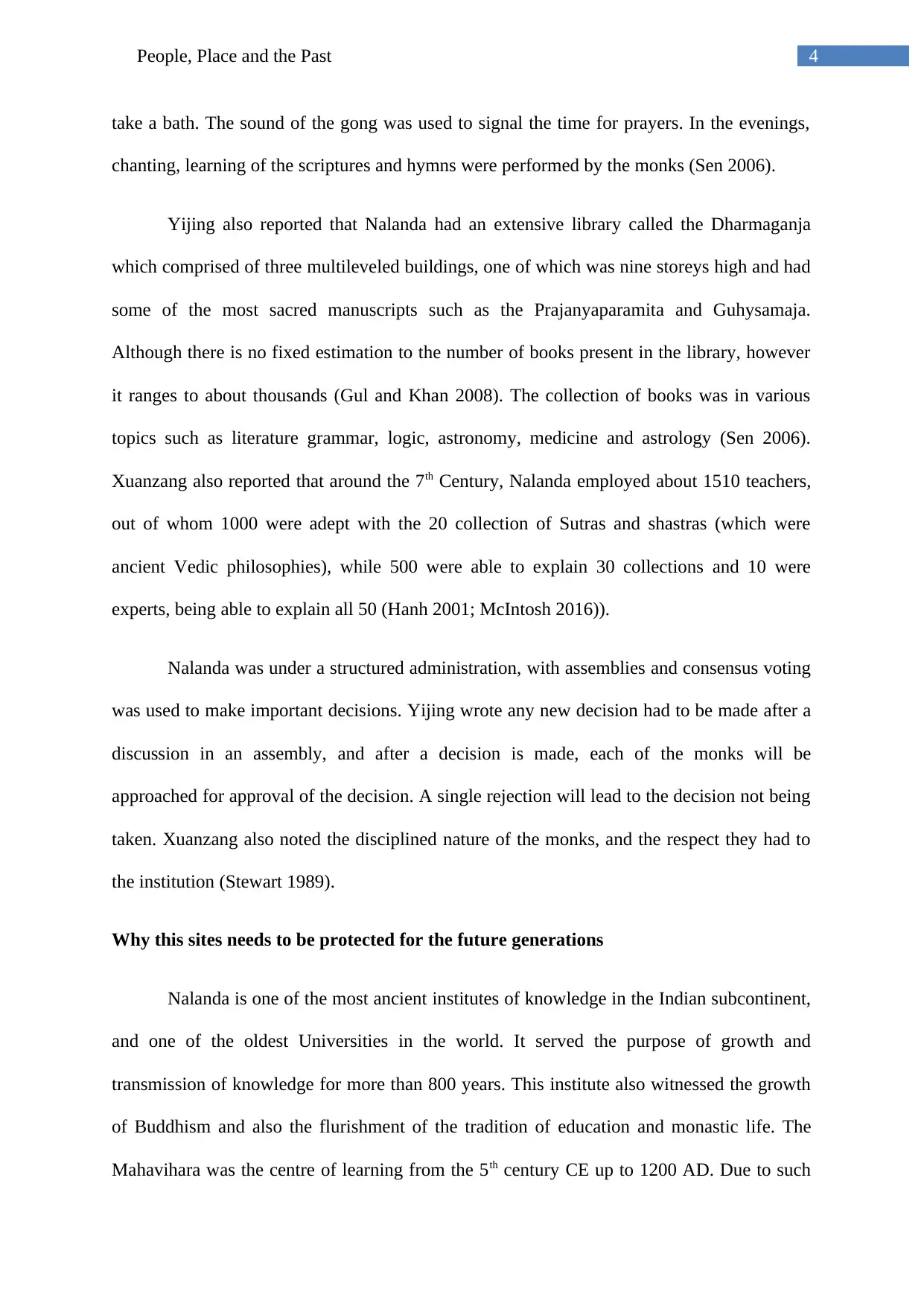
4People, Place and the Past
take a bath. The sound of the gong was used to signal the time for prayers. In the evenings,
chanting, learning of the scriptures and hymns were performed by the monks (Sen 2006).
Yijing also reported that Nalanda had an extensive library called the Dharmaganja
which comprised of three multileveled buildings, one of which was nine storeys high and had
some of the most sacred manuscripts such as the Prajanyaparamita and Guhysamaja.
Although there is no fixed estimation to the number of books present in the library, however
it ranges to about thousands (Gul and Khan 2008). The collection of books was in various
topics such as literature grammar, logic, astronomy, medicine and astrology (Sen 2006).
Xuanzang also reported that around the 7th Century, Nalanda employed about 1510 teachers,
out of whom 1000 were adept with the 20 collection of Sutras and shastras (which were
ancient Vedic philosophies), while 500 were able to explain 30 collections and 10 were
experts, being able to explain all 50 (Hanh 2001; McIntosh 2016)).
Nalanda was under a structured administration, with assemblies and consensus voting
was used to make important decisions. Yijing wrote any new decision had to be made after a
discussion in an assembly, and after a decision is made, each of the monks will be
approached for approval of the decision. A single rejection will lead to the decision not being
taken. Xuanzang also noted the disciplined nature of the monks, and the respect they had to
the institution (Stewart 1989).
Why this sites needs to be protected for the future generations
Nalanda is one of the most ancient institutes of knowledge in the Indian subcontinent,
and one of the oldest Universities in the world. It served the purpose of growth and
transmission of knowledge for more than 800 years. This institute also witnessed the growth
of Buddhism and also the flurishment of the tradition of education and monastic life. The
Mahavihara was the centre of learning from the 5th century CE up to 1200 AD. Due to such
take a bath. The sound of the gong was used to signal the time for prayers. In the evenings,
chanting, learning of the scriptures and hymns were performed by the monks (Sen 2006).
Yijing also reported that Nalanda had an extensive library called the Dharmaganja
which comprised of three multileveled buildings, one of which was nine storeys high and had
some of the most sacred manuscripts such as the Prajanyaparamita and Guhysamaja.
Although there is no fixed estimation to the number of books present in the library, however
it ranges to about thousands (Gul and Khan 2008). The collection of books was in various
topics such as literature grammar, logic, astronomy, medicine and astrology (Sen 2006).
Xuanzang also reported that around the 7th Century, Nalanda employed about 1510 teachers,
out of whom 1000 were adept with the 20 collection of Sutras and shastras (which were
ancient Vedic philosophies), while 500 were able to explain 30 collections and 10 were
experts, being able to explain all 50 (Hanh 2001; McIntosh 2016)).
Nalanda was under a structured administration, with assemblies and consensus voting
was used to make important decisions. Yijing wrote any new decision had to be made after a
discussion in an assembly, and after a decision is made, each of the monks will be
approached for approval of the decision. A single rejection will lead to the decision not being
taken. Xuanzang also noted the disciplined nature of the monks, and the respect they had to
the institution (Stewart 1989).
Why this sites needs to be protected for the future generations
Nalanda is one of the most ancient institutes of knowledge in the Indian subcontinent,
and one of the oldest Universities in the world. It served the purpose of growth and
transmission of knowledge for more than 800 years. This institute also witnessed the growth
of Buddhism and also the flurishment of the tradition of education and monastic life. The
Mahavihara was the centre of learning from the 5th century CE up to 1200 AD. Due to such

5People, Place and the Past
rich historical significance, this site was named a ‘World Heritage Site’ by UNESCO on 2016
(Whc.unesco.org, 2018; Chaudhary 2016). The Mahavihara also stands out in its planning
and architecture, reflecting upon the artistic traditions of ancient India, and also served as
prototypes for more constructions. It was the earliest planned university in the subcontinent,
and was thus one of the most significant structures which aimed in the propagation of
knowledge. The art and knowledge from Nalanda found its way to Thailand and Malayan
Archipelago as well as Nepal, Myanmar and Tibet, where monasteries and educational
institutes were modeled after Nalanda. The university shored that they were much ahead of
its time in the way they used democratic system for administrative work. Also, they had
rigorous screening process for the admission of students. The institute amalgamated the art
and science of debate to a tool of higher education. The influence of this system can also be
found in the monasteries of Sri Lanka, Nepal and Tibet. This showed how Nalanda was an
influential institute, whose influences can still find its traces in our modern day civilization
(Bhattacharyya and Guha 2016). The archeological remains of Nalanda Mahavihara, is a
proof of the artistic and architectural ingenuity in its planning and layout of the institute.
Moreover, the existing building materials found on the sites, its architectural display and
various embellishments adorning the place is an ample proof of ancient wisdom and
knowledge. It is also possible to understand the evolution of these art form and architectural
knowledge by studying the structural remains of the layers of development of the Mahavihara
that occurred in its almost 800 year lifespan. The two steps of structures, the Vihara (which
was a residential and scholastic quarters) and chaityas (temples) which were commonly found
in the Mahavihara. Their positioning in the premise is the evidence of a well planned layout
followed by Nalanda. Nalanda also boasted a plethora of movable and immovable artifacts,
which exhibits immense developments and changes in the Buddhist belief system (Upasak
2000).
rich historical significance, this site was named a ‘World Heritage Site’ by UNESCO on 2016
(Whc.unesco.org, 2018; Chaudhary 2016). The Mahavihara also stands out in its planning
and architecture, reflecting upon the artistic traditions of ancient India, and also served as
prototypes for more constructions. It was the earliest planned university in the subcontinent,
and was thus one of the most significant structures which aimed in the propagation of
knowledge. The art and knowledge from Nalanda found its way to Thailand and Malayan
Archipelago as well as Nepal, Myanmar and Tibet, where monasteries and educational
institutes were modeled after Nalanda. The university shored that they were much ahead of
its time in the way they used democratic system for administrative work. Also, they had
rigorous screening process for the admission of students. The institute amalgamated the art
and science of debate to a tool of higher education. The influence of this system can also be
found in the monasteries of Sri Lanka, Nepal and Tibet. This showed how Nalanda was an
influential institute, whose influences can still find its traces in our modern day civilization
(Bhattacharyya and Guha 2016). The archeological remains of Nalanda Mahavihara, is a
proof of the artistic and architectural ingenuity in its planning and layout of the institute.
Moreover, the existing building materials found on the sites, its architectural display and
various embellishments adorning the place is an ample proof of ancient wisdom and
knowledge. It is also possible to understand the evolution of these art form and architectural
knowledge by studying the structural remains of the layers of development of the Mahavihara
that occurred in its almost 800 year lifespan. The two steps of structures, the Vihara (which
was a residential and scholastic quarters) and chaityas (temples) which were commonly found
in the Mahavihara. Their positioning in the premise is the evidence of a well planned layout
followed by Nalanda. Nalanda also boasted a plethora of movable and immovable artifacts,
which exhibits immense developments and changes in the Buddhist belief system (Upasak
2000).

6People, Place and the Past
The excavated remains are a proof of ancient pedagogy and philosophical discourses
that influenced ancient Indian art, culture, architecture and belief systems. The structures also
evidences an assimilation of developments in the various planning, architectural and artistic
prototypes, which later served as an influence over the greater part of Asia. The remains also
mark the early beginnings o0f systematic planning for an establishment of education. The
systematic planning also ensured seamless development of the Mahavihara over the next few
centuries, which have Nalanda a unique visual identity. Nalanda influence was also found
among the Tebetian Monasteries and the monastic city of Paharpur, Bangladesh which is also
now a UNESCO world heritage site. Interchange of architectural knowledge could be
evidenced from the structural standardization of chaityas or temples, which as subsequently
found in other cities like Gandhara, which shows how other Ancient cities exchanged
architectural techniques for construction. The stucco of Nalanda have heavily influenced the
architecture of Thailand, and the art of metal was also influenced the social life and art of
Tibet, Burma, Malay Archipelago and Nepal (Ghosh 2017).
The Nalanda Mahavihara as a center of higher education marks the apex of the
evolution of the monastic establishment, making it the earliest planned university, built in
medieval India. The establishment was able to use a merit based approach and was open to all
forms of contemporary knowledge sources and learning systems which were practiced in the
Indian subcontinent. The scholarships provided by the Mahavihara were a proof of the
importance of knowledge and education during that period. The institute amalgamated the
basics of Indian systems of logic and philosophy, the principles of Yogachara, debates and
madhamika schools, as tools of imparting knowledge to its students. Such influences survive
till today in the form of cultural customs still followed by several sects of Buddhism in Asia
and several modern day educational establishments which are named after this ancient relic
(Bhattacharya and Guha 2016).
The excavated remains are a proof of ancient pedagogy and philosophical discourses
that influenced ancient Indian art, culture, architecture and belief systems. The structures also
evidences an assimilation of developments in the various planning, architectural and artistic
prototypes, which later served as an influence over the greater part of Asia. The remains also
mark the early beginnings o0f systematic planning for an establishment of education. The
systematic planning also ensured seamless development of the Mahavihara over the next few
centuries, which have Nalanda a unique visual identity. Nalanda influence was also found
among the Tebetian Monasteries and the monastic city of Paharpur, Bangladesh which is also
now a UNESCO world heritage site. Interchange of architectural knowledge could be
evidenced from the structural standardization of chaityas or temples, which as subsequently
found in other cities like Gandhara, which shows how other Ancient cities exchanged
architectural techniques for construction. The stucco of Nalanda have heavily influenced the
architecture of Thailand, and the art of metal was also influenced the social life and art of
Tibet, Burma, Malay Archipelago and Nepal (Ghosh 2017).
The Nalanda Mahavihara as a center of higher education marks the apex of the
evolution of the monastic establishment, making it the earliest planned university, built in
medieval India. The establishment was able to use a merit based approach and was open to all
forms of contemporary knowledge sources and learning systems which were practiced in the
Indian subcontinent. The scholarships provided by the Mahavihara were a proof of the
importance of knowledge and education during that period. The institute amalgamated the
basics of Indian systems of logic and philosophy, the principles of Yogachara, debates and
madhamika schools, as tools of imparting knowledge to its students. Such influences survive
till today in the form of cultural customs still followed by several sects of Buddhism in Asia
and several modern day educational establishments which are named after this ancient relic
(Bhattacharya and Guha 2016).
Paraphrase This Document
Need a fresh take? Get an instant paraphrase of this document with our AI Paraphraser
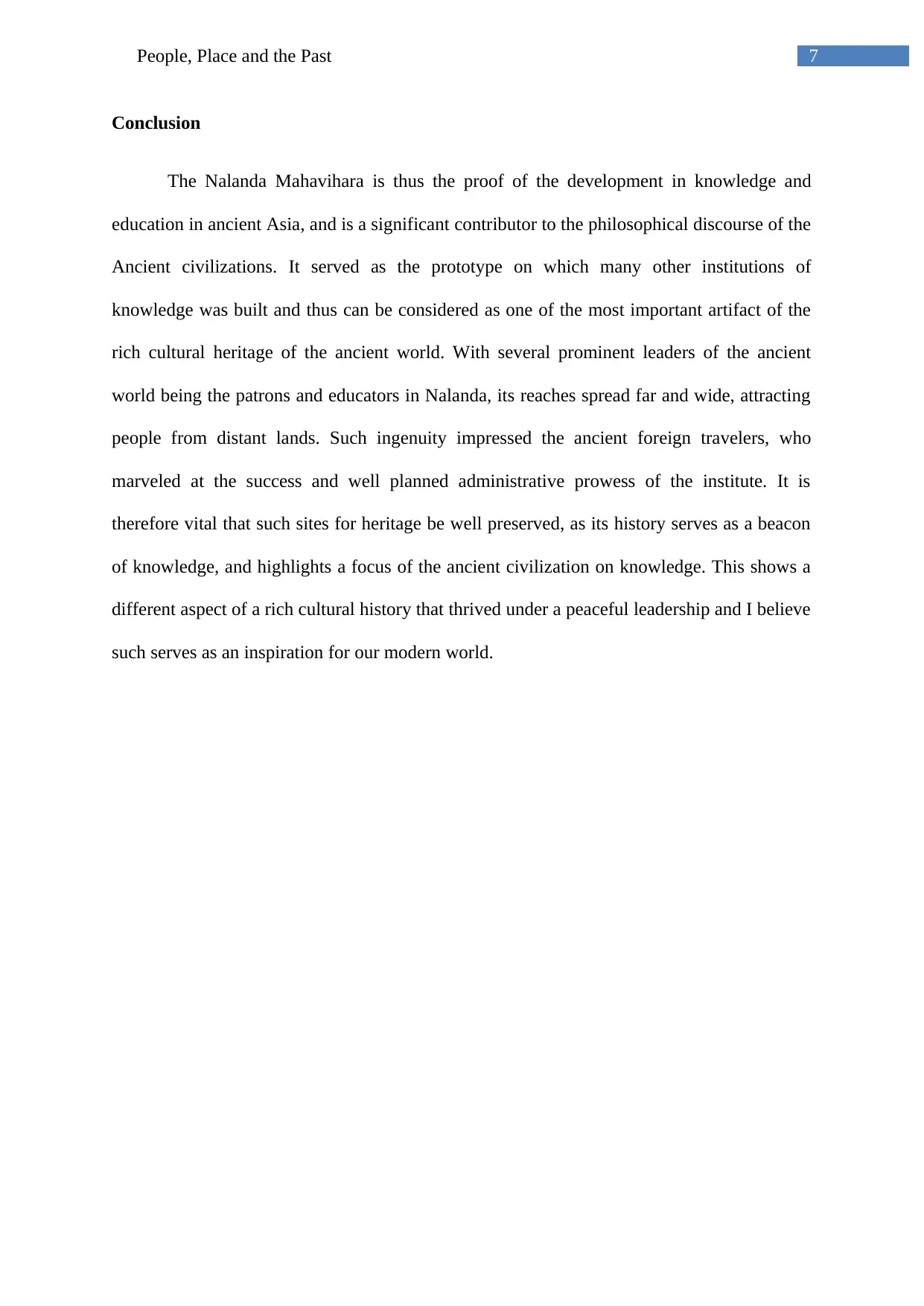
7People, Place and the Past
Conclusion
The Nalanda Mahavihara is thus the proof of the development in knowledge and
education in ancient Asia, and is a significant contributor to the philosophical discourse of the
Ancient civilizations. It served as the prototype on which many other institutions of
knowledge was built and thus can be considered as one of the most important artifact of the
rich cultural heritage of the ancient world. With several prominent leaders of the ancient
world being the patrons and educators in Nalanda, its reaches spread far and wide, attracting
people from distant lands. Such ingenuity impressed the ancient foreign travelers, who
marveled at the success and well planned administrative prowess of the institute. It is
therefore vital that such sites for heritage be well preserved, as its history serves as a beacon
of knowledge, and highlights a focus of the ancient civilization on knowledge. This shows a
different aspect of a rich cultural history that thrived under a peaceful leadership and I believe
such serves as an inspiration for our modern world.
Conclusion
The Nalanda Mahavihara is thus the proof of the development in knowledge and
education in ancient Asia, and is a significant contributor to the philosophical discourse of the
Ancient civilizations. It served as the prototype on which many other institutions of
knowledge was built and thus can be considered as one of the most important artifact of the
rich cultural heritage of the ancient world. With several prominent leaders of the ancient
world being the patrons and educators in Nalanda, its reaches spread far and wide, attracting
people from distant lands. Such ingenuity impressed the ancient foreign travelers, who
marveled at the success and well planned administrative prowess of the institute. It is
therefore vital that such sites for heritage be well preserved, as its history serves as a beacon
of knowledge, and highlights a focus of the ancient civilization on knowledge. This shows a
different aspect of a rich cultural history that thrived under a peaceful leadership and I believe
such serves as an inspiration for our modern world.
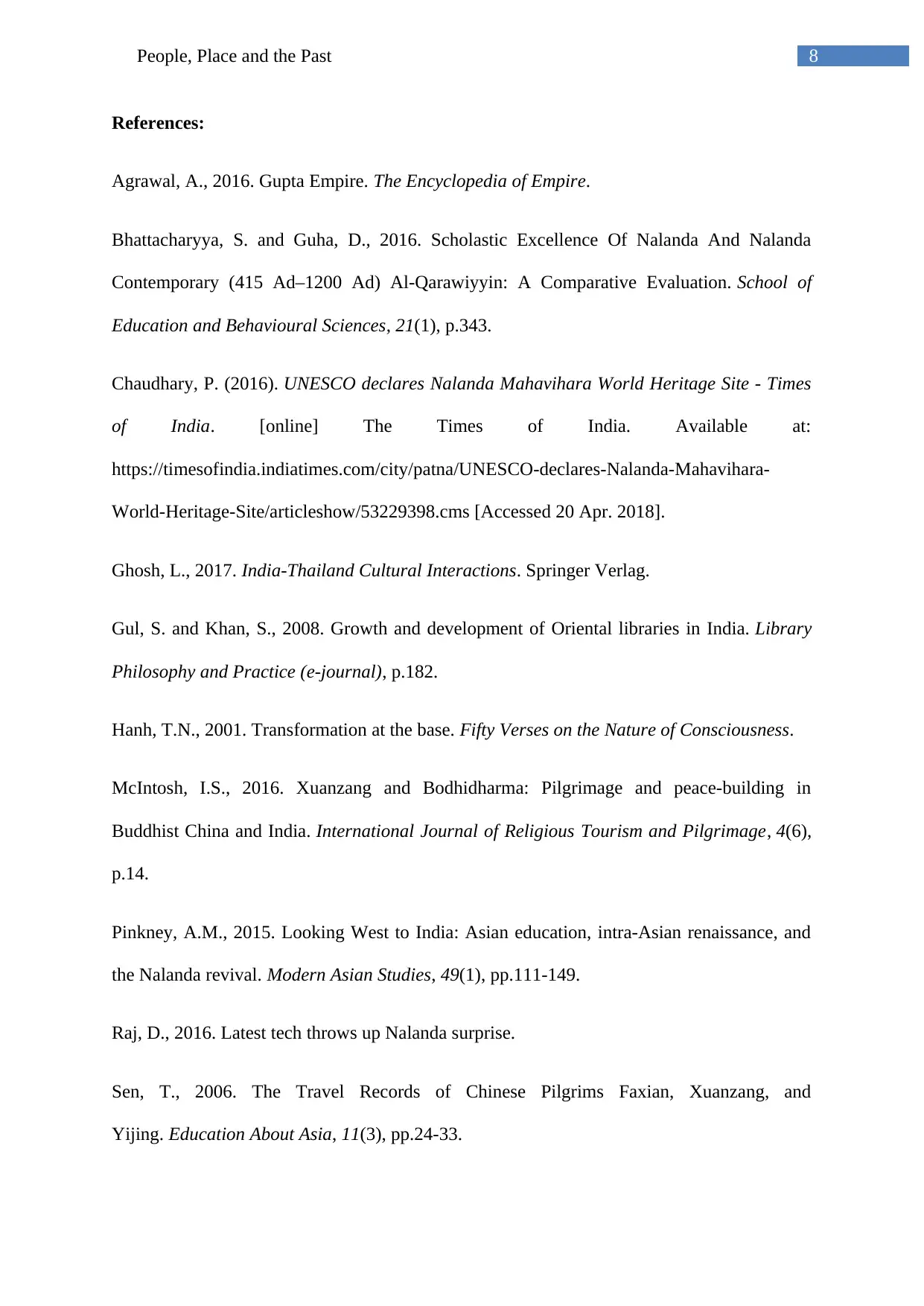
8People, Place and the Past
References:
Agrawal, A., 2016. Gupta Empire. The Encyclopedia of Empire.
Bhattacharyya, S. and Guha, D., 2016. Scholastic Excellence Of Nalanda And Nalanda
Contemporary (415 Ad–1200 Ad) Al-Qarawiyyin: A Comparative Evaluation. School of
Education and Behavioural Sciences, 21(1), p.343.
Chaudhary, P. (2016). UNESCO declares Nalanda Mahavihara World Heritage Site - Times
of India. [online] The Times of India. Available at:
https://timesofindia.indiatimes.com/city/patna/UNESCO-declares-Nalanda-Mahavihara-
World-Heritage-Site/articleshow/53229398.cms [Accessed 20 Apr. 2018].
Ghosh, L., 2017. India-Thailand Cultural Interactions. Springer Verlag.
Gul, S. and Khan, S., 2008. Growth and development of Oriental libraries in India. Library
Philosophy and Practice (e-journal), p.182.
Hanh, T.N., 2001. Transformation at the base. Fifty Verses on the Nature of Consciousness.
McIntosh, I.S., 2016. Xuanzang and Bodhidharma: Pilgrimage and peace-building in
Buddhist China and India. International Journal of Religious Tourism and Pilgrimage, 4(6),
p.14.
Pinkney, A.M., 2015. Looking West to India: Asian education, intra-Asian renaissance, and
the Nalanda revival. Modern Asian Studies, 49(1), pp.111-149.
Raj, D., 2016. Latest tech throws up Nalanda surprise.
Sen, T., 2006. The Travel Records of Chinese Pilgrims Faxian, Xuanzang, and
Yijing. Education About Asia, 11(3), pp.24-33.
References:
Agrawal, A., 2016. Gupta Empire. The Encyclopedia of Empire.
Bhattacharyya, S. and Guha, D., 2016. Scholastic Excellence Of Nalanda And Nalanda
Contemporary (415 Ad–1200 Ad) Al-Qarawiyyin: A Comparative Evaluation. School of
Education and Behavioural Sciences, 21(1), p.343.
Chaudhary, P. (2016). UNESCO declares Nalanda Mahavihara World Heritage Site - Times
of India. [online] The Times of India. Available at:
https://timesofindia.indiatimes.com/city/patna/UNESCO-declares-Nalanda-Mahavihara-
World-Heritage-Site/articleshow/53229398.cms [Accessed 20 Apr. 2018].
Ghosh, L., 2017. India-Thailand Cultural Interactions. Springer Verlag.
Gul, S. and Khan, S., 2008. Growth and development of Oriental libraries in India. Library
Philosophy and Practice (e-journal), p.182.
Hanh, T.N., 2001. Transformation at the base. Fifty Verses on the Nature of Consciousness.
McIntosh, I.S., 2016. Xuanzang and Bodhidharma: Pilgrimage and peace-building in
Buddhist China and India. International Journal of Religious Tourism and Pilgrimage, 4(6),
p.14.
Pinkney, A.M., 2015. Looking West to India: Asian education, intra-Asian renaissance, and
the Nalanda revival. Modern Asian Studies, 49(1), pp.111-149.
Raj, D., 2016. Latest tech throws up Nalanda surprise.
Sen, T., 2006. The Travel Records of Chinese Pilgrims Faxian, Xuanzang, and
Yijing. Education About Asia, 11(3), pp.24-33.
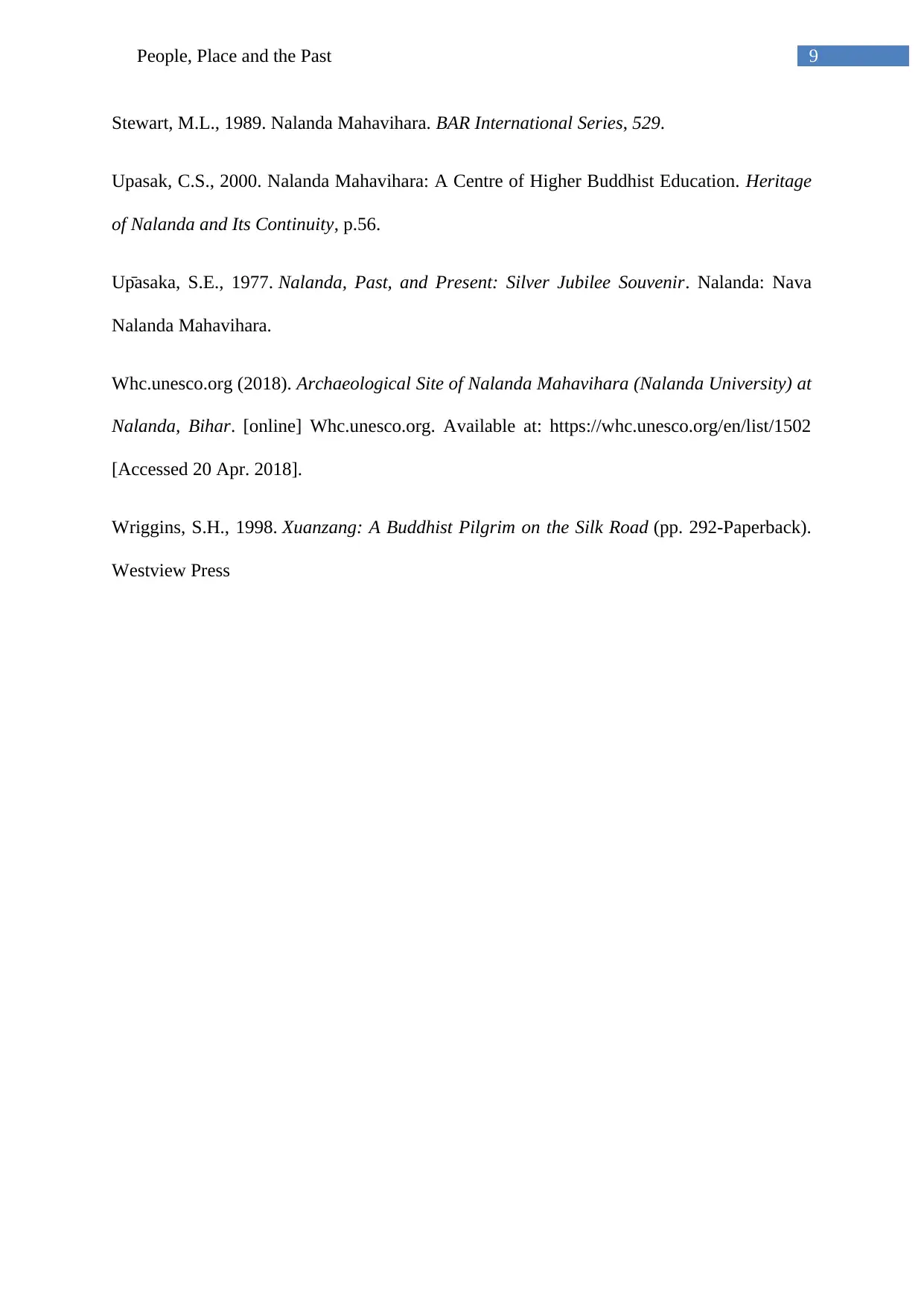
9People, Place and the Past
Stewart, M.L., 1989. Nalanda Mahavihara. BAR International Series, 529.
Upasak, C.S., 2000. Nalanda Mahavihara: A Centre of Higher Buddhist Education. Heritage
of Nalanda and Its Continuity, p.56.
Up̄asaka, S.E., 1977. Nalanda, Past, and Present: Silver Jubilee Souvenir. Nalanda: Nava
Nalanda Mahavihara.
Whc.unesco.org (2018). Archaeological Site of Nalanda Mahavihara (Nalanda University) at
Nalanda, Bihar. [online] Whc.unesco.org. Available at: https://whc.unesco.org/en/list/1502
[Accessed 20 Apr. 2018].
Wriggins, S.H., 1998. Xuanzang: A Buddhist Pilgrim on the Silk Road (pp. 292-Paperback).
Westview Press
Stewart, M.L., 1989. Nalanda Mahavihara. BAR International Series, 529.
Upasak, C.S., 2000. Nalanda Mahavihara: A Centre of Higher Buddhist Education. Heritage
of Nalanda and Its Continuity, p.56.
Up̄asaka, S.E., 1977. Nalanda, Past, and Present: Silver Jubilee Souvenir. Nalanda: Nava
Nalanda Mahavihara.
Whc.unesco.org (2018). Archaeological Site of Nalanda Mahavihara (Nalanda University) at
Nalanda, Bihar. [online] Whc.unesco.org. Available at: https://whc.unesco.org/en/list/1502
[Accessed 20 Apr. 2018].
Wriggins, S.H., 1998. Xuanzang: A Buddhist Pilgrim on the Silk Road (pp. 292-Paperback).
Westview Press
1 out of 10
Your All-in-One AI-Powered Toolkit for Academic Success.
+13062052269
info@desklib.com
Available 24*7 on WhatsApp / Email
![[object Object]](/_next/static/media/star-bottom.7253800d.svg)
Unlock your academic potential
© 2024 | Zucol Services PVT LTD | All rights reserved.